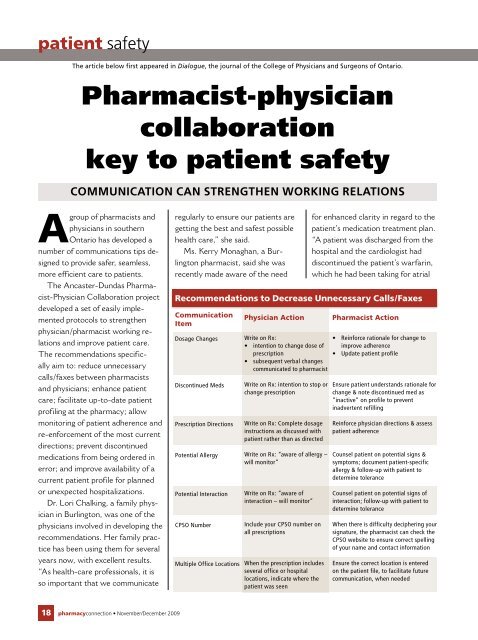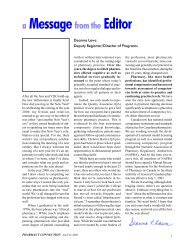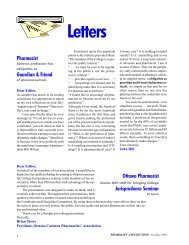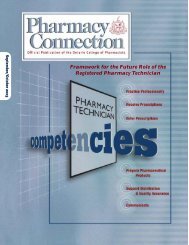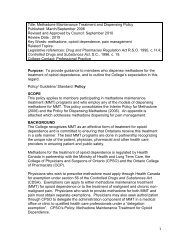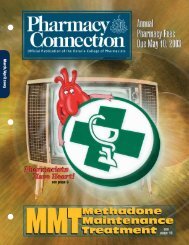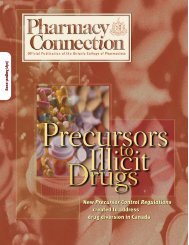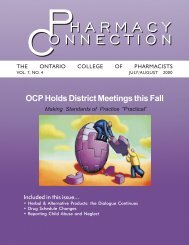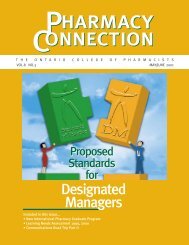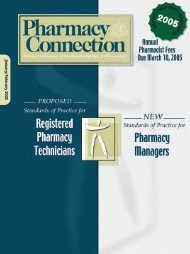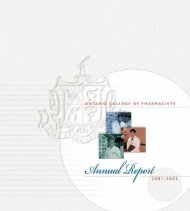November/December 2009 - Ontario College of Pharmacists
November/December 2009 - Ontario College of Pharmacists
November/December 2009 - Ontario College of Pharmacists
You also want an ePaper? Increase the reach of your titles
YUMPU automatically turns print PDFs into web optimized ePapers that Google loves.
patient safety<br />
The article below first appeared in Dialogue, the journal <strong>of</strong> the <strong>College</strong> <strong>of</strong> Physicians and Surgeons <strong>of</strong> <strong>Ontario</strong>.<br />
Pharmacist-physician<br />
collaboration<br />
key to patient safety<br />
COMMUNICATION CAN STRENGTHEN WORKING RELATIONS<br />
A<br />
group <strong>of</strong> pharmacists and<br />
physicians in southern<br />
<strong>Ontario</strong> has developed a<br />
number <strong>of</strong> communications tips designed<br />
to provide safer, seamless,<br />
more efficient care to patients.<br />
The Ancaster-Dundas Pharmacist-Physician<br />
Collaboration project<br />
developed a set <strong>of</strong> easily implemented<br />
protocols to strengthen<br />
physician/pharmacist working relations<br />
and improve patient care.<br />
The recommendations specifically<br />
aim to: reduce unnecessary<br />
calls/faxes between pharmacists<br />
and physicians; enhance patient<br />
care; facilitate up-to-date patient<br />
pr<strong>of</strong>iling at the pharmacy; allow<br />
monitoring <strong>of</strong> patient adherence and<br />
re-enforcement <strong>of</strong> the most current<br />
directions; prevent discontinued<br />
medications from being ordered in<br />
error; and improve availability <strong>of</strong> a<br />
current patient pr<strong>of</strong>ile for planned<br />
or unexpected hospitalizations.<br />
Dr. Lori Chalking, a family physician<br />
in Burlington, was one <strong>of</strong> the<br />
physicians involved in developing the<br />
recommendations. Her family practice<br />
has been using them for several<br />
years now, with excellent results.<br />
“As health-care pr<strong>of</strong>essionals, it is<br />
so important that we communicate<br />
regularly to ensure our patients are<br />
getting the best and safest possible<br />
health care,” she said.<br />
Ms. Kerry Monaghan, a Burlington<br />
pharmacist, said she was<br />
recently made aware <strong>of</strong> the need<br />
Recommendations to Decrease Unnecessary Calls/Faxes<br />
Communication<br />
Item<br />
Dosage Changes<br />
Discontinued Meds<br />
Prescription Directions<br />
Potential Allergy<br />
Potential Interaction<br />
CPSO Number<br />
Multiple Office Locations<br />
Physician Action<br />
Write on Rx:<br />
• intention to change dose <strong>of</strong><br />
prescription<br />
• subsequent verbal changes<br />
communicated to pharmacist<br />
Write on Rx: intention to stop or<br />
change prescription<br />
Write on Rx: Complete dosage<br />
instructions as discussed with<br />
patient rather than as directed<br />
Write on Rx: “aware <strong>of</strong> allergy –<br />
will monitor”<br />
Write on Rx: “aware <strong>of</strong><br />
interaction – will monitor”<br />
Include your CPSO number on<br />
all prescriptions<br />
When the prescription includes<br />
several <strong>of</strong>fice or hospital<br />
locations, indicate where the<br />
patient was seen<br />
for enhanced clarity in regard to the<br />
patient’s medication treatment plan.<br />
“A patient was discharged from the<br />
hospital and the cardiologist had<br />
discontinued the patient’s warfarin,<br />
which he had been taking for atrial<br />
Pharmacist Action<br />
• Reinforce rationale for change to<br />
improve adherence<br />
• Update patient pr<strong>of</strong>ile<br />
Ensure patient understands rationale for<br />
change & note discontinued med as<br />
“inactive” on pr<strong>of</strong>ile to prevent<br />
inadvertent refilling<br />
Reinforce physician directions & assess<br />
patient adherence<br />
Counsel patient on potential signs &<br />
symptoms; document patient-specific<br />
allergy & follow-up with patient to<br />
determine tolerance<br />
Counsel patient on potential signs <strong>of</strong><br />
interaction; follow-up with patient to<br />
determine tolerance<br />
When there is difficulty deciphering your<br />
signature, the pharmacist can check the<br />
CPSO website to ensure correct spelling<br />
<strong>of</strong> your name and contact information<br />
Ensure the correct location is entered<br />
on the patient file, to facilitate future<br />
communication, when needed<br />
18 pharmacyconnection • <strong>November</strong>/<strong>December</strong> <strong>2009</strong>


